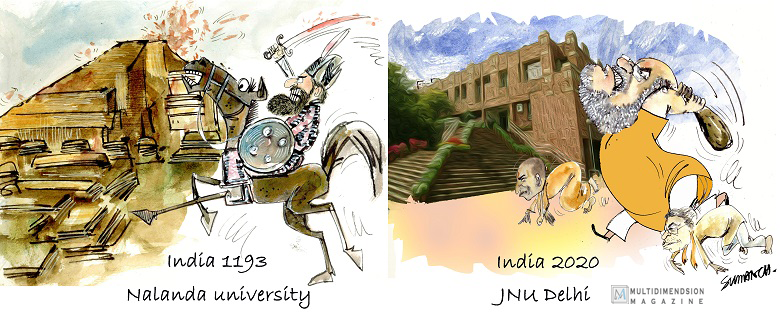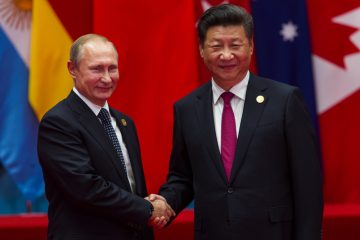Written by : Debkumar Mitra
Kolkata, India
Illustration : Suman Choudhury
A little more than 50 years after that famous student uprising in the streets of Paris, 1968 is being replayed in Delhi, Kolkata, Mumbai, Bangalore, and other cities of India. While, the French students led by people such as Danny the Red fought with President Charles de Gaulle’s gendarme for sexual freedom, war in Vietnam and jobs, in India the students are out in the openapparently, if one goes by the official media versions,to protest police excesses on university campuses.
The situation has been on the boil on the campuses since the abrogation of Article 370 of the Indian constitution that accorded a special status to the Indian state of Jammu and Kashmir last year but it spilled over as soon as the Citizenship Amendment Act(CAA) was passed in the Indian parliament in December.
Earlier Aligarh Muslim University students in the state of Uttar Pradesh faced a brutal police action inside the campus while protesting against the shut down in Kashmir. Reports on the severity of police action was and continues to be absent from Indian mainstream media but on social media ‘unconfirmed’ video feeds unmasked the cruelty of the Uttar Pradesh police. Chief Minister Yogi Adityanath’s administration continues to deny all allegations of police excesses.
What seemed to come as a surprise to student community in general is the urgency from both the Bharatiya Janata Party(BJP)-led central government and in states where the party or its allies are in power to curb any form of peaceful dissent. The Delhi Police action at Jamia Millia Islamia is a case in point. The police without any perceptible provocation entered the campus mercilessly beating up students. The incident in the heart of the country’s capital attracted international attention for the first time and acted as a trigger to a wave of protests across the country. It also pitched the students against an uncompromising state power that could be seen only in battle-gear ready to snuff out even the murmur of a protest.
The disenchantment on campuses has been palpable for some time, with the economy on a tailspin no amount of window-dressing is not being able to address the demands for jobs and livelihood of tens of thousands youth emerging out of universities. The enactment of CAA only added fodder to a slow burning fire of disillusionment. Without going into its merits the contours of CAA appears to be ‘biased’ against Muslims. Also, the experience of running the National Register of Citizens (NRC) program in northeastern state of Assam where more than 1.9 million people were excluded from the final list of citizens rekindled the dreaded memories of Nazi Germany and fascism. The impassioned appeals of several members of the civil society seemed to resonate even on campuses that wear the apolitical tag on their sleeves. No one can remember when did the students of St Stephen’s College in Delhi left classes to protest on a political issue such as the CAA.
Democracy is under attack, the opposition had been saying this for a long time. But the young did vote to bring Narendra Modi back to power ignoring such calls. The CAA, NRP and NRC seemed to change it all. Suddenly, BJP and its ideological mentor the Rashtriya Swayamsevak Sangh (RSS) are labeled as anti-constitution and as people whose policies are detrimental to the unity of India. The Home Minister Amit Shah’s hardsell of CAA and NRC also queered the pitch for the BJP. In addition, in the urban India people have started viewing BJP a party of feudal landlords that is more interested in building a gigantic temple for Rama at Ayodhya and promoting cow urine as the panacea for all diseases from hair-fall to heart ailments. Even the business-friendly Prime Minister is seen to take the help to Gurus to tackle the rising discontent.
The other tactic being used by the Hindutva supporters is to silence protests on campuses attacking the leaders and key organizers of the movement. These attacks, like the televised one at the Jawaharlal Nehru University in Delhi or the very recent one at the Visva-Bharati University, Santiniketan, have been carried out by goons backed by Akhil Bharatiya Vidyarthi Parishad (AVBP). This strategy is viewed by many as an effort to strike terror at heart of the campuses. The blood-drenched faces of students have steeled the nerves of the students. While they have not resorted to any kind of violence, ABVP is gradually finding itself to be isolated. In all these attacks the role of the university heads and the police have come under scanner. Their inability to protect students has been criticized even by the venerable science journal Nature.
Till recently, dissent as an integral part of democracy has been largely under control by a media that decided to look the other way and BJP IT cell that virtually controlled social media through vicious trolling of civil society members. While both the official media and the IT cell continue to play ball with BJP and RSS, their control seems to be loosening if only a little. The fake news attacks on student leaders and anti-CAA movements are quickly put down and the younger members are seen counter-attacking the trolls. ABVP has been a butt of ridicule while some calling them by a new name Aao bhai Vidyarthi Pite (Come brother let’s bash students). The huge rallies across the country now have a significant number of youth. There is poetry, songs and remarkable oration punctuated by rhythmic slogans of freedom. These are the elements of a new language for rallies in India. Even in the fame of constant intimidation, fear of harassment, threat and police brutality the movement has been non-violent. This newness is attracting even the fence-sitters and the name calling of the silent personalities have begun. Even Amitabh Bachchan the famous Indian actor has not been spared: An altered poster of the film The Silence of the Lambs, shows his face with a butterfly sealing his lips and a caption, the silence of the lambu (the tall).
However, the biggest surprise of all that would be a headache for the ruling class is the number of women participating in the movement. Be it the grandmothers of Shaheen Bagh in Delhi, the sleepless mothers at Park Circus or JNU Student Union president Aishee Ghosh, the resolve in the eyes of these women is remarkable. The calmness in their approach and their determination to save India from peril are the hallmark of a non-violent protest that would make even Mahatma Gandhi proud. Finally, the Indian woman along with the young is rising. It is still an urban phenomenon but who has seen the morrow.




